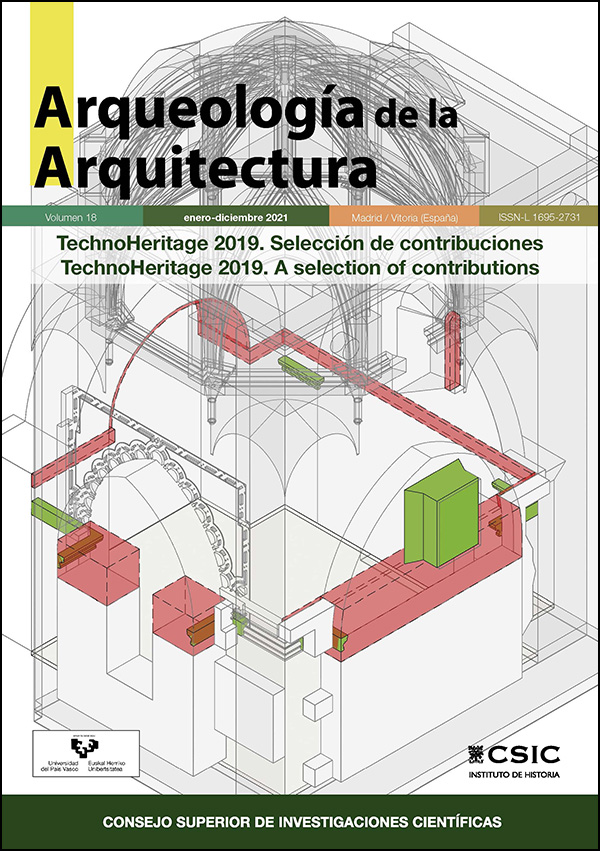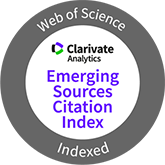Reflections and criteria related to the creation of BIM models of historical buildings
DOI:
https://doi.org/10.3989/arq.arqt.2021.005Keywords:
HBIM, cultural heritage, built heritage, evolutionary sequence, archaeology of architecture, early medieval architectureAbstract
The main objective of this paper is to analyse the creation process of a BIM model applied to the field of historical buildings, taking into consideration their specific features in order to reach a successful and efficient use. For this purpose, three early medieval buildings have been studied. A specific modelling strategy has been applied to each of them and the research has been focused on several aspects, such as the level of formal simplification, the level of metric accuracy or even the level of development (LOD) properly adapted to the singularities of historical buildings. As result of this analysis, some conclusions are described, of which common thread is to propose keys to reach the feasibility of the application of the BIM methodology in the field of cultural heritage, both during the creation of the model and when using it.
Downloads
References
Banfi, F. 2017: "BIM orientation: grades of generation and information for different type of analysis and management process", The International Archives of the Photogrammetry, Remote Sensing and Spatial Information Sciences, XLII-2/W5, pp. 57-64. https://doi.org/10.5194/isprs-archives-XLII-2-W5-57-2017
Banfi, F., Brumana, R. y Stanga, C. 2019: "Extended reality and informative models for the architectural heritage: from scan-to-BIM process to virtual and augmented reality", Virtual Archaeology Review, 10, pp. 14-30. https://doi.org/10.4995/var.2019.11923
Bruno, N. y Roncella, R. 2018: "A restoration oriented HBIM system for cultural heritage documentation: the case study of Parma catedral", The International Archives of the Photogrammetry, Remote Sensing and Spatial Information Sciences, XLII-2, pp. 171-178. https://doi.org/10.5194/isprs-archives-XLII-2-171-2018
Bruno, N. y Roncella, R. 2019: "HBIM for Conservation: A New Proposal for Information Modeling", Remote Sensing, 11. https://doi.org/10.3390/rs11151751
Caballero, L. 2010: "Experiencia metodológica en Arqueología de la Arquitectura de un grupo de investigación. Instituto de Historia. CSIC. Madrid", en C. Martín y E. de Vega (coords.), Arqueología aplicada al estudio e intervención de edificios históricos. Últimas tendencias metodológicas, pp. 103-120. Ministerio de Cultura, Madrid.
Castellano, M. y Pinto, F. 2019: "Dimensions and Levels of Knowledge in Heritage Building Information Modelling, HBIM: The model of the Charterhouse of Jerez (Cádiz, Spain)", Digital Applications in Archaeology and Cultural Heritage, 14. https://doi.org/10.1016/j.daach.2019.e00110
Guía de usuarios BIM, Documento 14. BIM aplicado al patrimonio cultural. Building SMART Spanish Chapter, Madrid. https://www.buildingsmart.es/recursos/gu%C3%ADas-ubim/
Jordan, I., Tzortzopoulos, P., García, J. y Pellicer, E. 2018: "Protocol to manage heritage-building interventions using heritage building information modelling (HBIM)", Sustainability, 10, 908. https://www.mdpi.com/2071-1050/10/4/908/pdf https://doi.org/10.3390/su10040908
Jouan, P. y Hallot, P. 2020: "Digital Twin: Research Framework to Support Preventive Conservation Policies", ISPRS International Journal of Geo- Information, vol 9, 228. https://doi.org/10.3390/ijgi9040228
Logothetis, S., Delinasiou, A. y Stylianidis, E. 2015: "Building information modelling for cultural heritage: a review", ISPRS Annals of the Photogrammetry, Remote Sensing and Spatial Information Sciences, II-5/W3, pp. 177-183. https://doi.org/10.5194/isprsannals-II-5-W3-177-2015
López, F. J., Lerones, P. M., Llamas, J., Gómez, J. y Zalama, E. 2018: "A Review of Heritage Building Information Modeling (H-BIM)", Multimodal Technologies and Interact, 2, 21. https://doi.org/10.3390/mti2020021
Martín, R., Cámara, L. y Murillo, J. I. 2018: "Análisis integrado de construcciones históricas: secuencia estratigráfica y diagnóstico patológico. Aplicación en la iglesia de Santa Clara (Córdoba)", Arqueología de la Arquitectura, 15, e067. https://doi.org/10.3989/arq.arqt.2018.001
Martín, R., Murillo, J. I. y Utrero, M.ª Á. 2020: "Key aspects regarding BIM for historical architecture. The church of San Cebrián de Mazote", en P.
Ortiz, F. Pinto, P. Verhagen y A. J. Prieto (eds.) Science and Digital Technology for Cultural Heritage - Interdisciplinary Approach to Diagnosis, Vulnerability, Risk Assessment and Graphic Information Models, pp. 47-53. Taylor & Francis Group, London.
Merchán, P., Salamanca, S., Merchán, M.ª J., Pérez, E. y Moreno, M.ª D. 2018: "Pasado, presente y futuro de los HBIM (Heritage/Historic Building Information Models)", en Actas de las XXXIX Jornadas de Automática, pp. 1077-1084. Universidad de Extremadura, Badajoz. http://hdl.handle.net/10662/8884
Murphy, M., McGovern, E. y Pavia, S. 2009: "Historic building information modelling (HBIM)", Structural Survey, 27 (4), pp. 311-327. https://doi.org/10.1108/02630800910985108
Nieto, J. E. y Moyano J. J. 2014: "El estudio paramental en el modelo de información del edificio histórico o 'Proyecto HBIM'", Virtual Archaeology Review, 5, pp. 73-85. https://doi.org/10.4995/var.2014.4183
Pocobelli, P., Bohem, J., Bryan, P., Still, J. y Grau-Bové, J. 2018: "BIM for heritage science: a review", Heritage Science, 6, 30. https://doi.org/10.1186/s40494-018-0191-4
Salvador, E., García-Valldecabres, J. y Viñals, M. J. 2018: "The use of HBIM models as a tool for dissemination and public use management of historical architecture: a review", International Journal of Sustainable Development and Planning, 13, pp. 96-107. https://doi.org/10.2495/SDP-V13-N1-96-107
The American Institute of Architects. 2013: AIA G202™-2013 Project Building Information Modelling Protocol Form. http://content.aia.org/sites/default/files/2016-09/AIA-G202-2013-Free-Sample-Preview.pdf
Published
How to Cite
Issue
Section
License
Copyright (c) 2021 Consejo Superior de Investigaciones Científicas (CSIC) - Universidad del País Vasco/Euskal Herriko Unibertsitatea (UPV/EHU)

This work is licensed under a Creative Commons Attribution 4.0 International License.
© CSIC. © UPV/EHU. Manuscripts published in both the print and online versions of this journal are the property of Consejo Superior de Investigaciones Científicas and Universidad del País Vasco/Euskal Herriko Unibertsitatea, and quoting this source is a requirement for any partial or full reproduction.
All contents of this electronic edition, except where otherwise noted, are distributed under a Creative Commons Attribution 4.0 International (CC BY 4.0) licence. You may read the basic information and the legal text of the licence. The indication of the CC BY 4.0 licence must be expressly stated in this way when necessary.
Self-archiving in repositories, personal webpages or similar, of any version other than the final version of the work produced by the publisher, is not allowed.
Funding data
Ministerio de Economía y Competitividad
Grant numbers HAR2016-78113-R
European Regional Development Fund
Grant numbers HAR2016-78113-R















